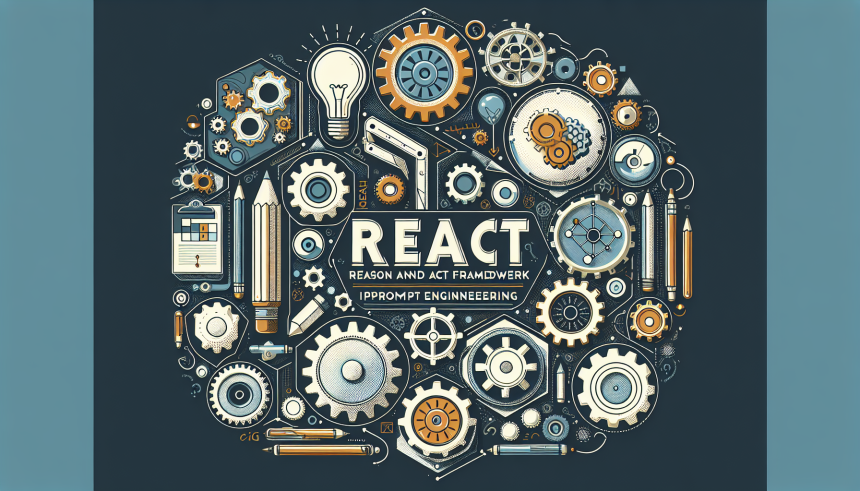Understanding the ReAct Framework in Prompt Engineering
1. The Concept of ReAct
ReAct stands for Reason and Act, a conceptual framework designed to enhance the capabilities of language models in prompt engineering. The primary aim of ReAct is to enable artificial intelligence (AI) systems, particularly language models like GPT-3 and its successors, to efficiently reason and act in contexts that require complex problem-solving. By incorporating reasoning within the interaction, ReAct allows models not only to generate responses but to do so by leveraging logical deductions and actionable conclusions.
2. The Importance of Prompt Engineering
Prompt engineering is a critical aspect of working with language models. It involves creating inputs that can help elicit the best possible outputs from AI systems. Understanding the intricacies of prompt design can significantly improve the performance of language models in various applications, from customer support to creative writing. With the ReAct framework, prompt engineering takes a step further by integrating reasoning into response generation, improving clarity, relevance, and contextual understanding.
3. Components of the ReAct Framework
The ReAct framework consists of two main components: “Reason” and “Act.”
3.1. Reason
The reasoning aspect deals with the model’s ability to analyze the information presented in the prompt. It involves:
-
Logical Deduction: The model evaluates input data, exploring connections and implications to formulate coherent responses.
-
Contextual Awareness: The model utilizes a context buffer to retain key information from prior prompts and responses, leading to more relevant outputs in ongoing conversations.
-
Inference Making: Reasoning enables the model to make educated assumptions based on available data, filling gaps when explicit information is missing.
3.2. Act
This component translates reasoning into actions, where the model takes outputs that constitute responses and executes relevant tasks. Key elements include:
-
Response Generation: The model produces articulate answers that not only respond to inquiries but can also suggest actions or steps based on its reasoning.
-
Task Execution: Beyond simple response generation, the model can suggest next steps or instructions for a user, adding a layer of interactivity to dialogues.
-
Goal Orientation: By understanding the user’s objectives, the model can tailor its responses to meet specific needs, effectively acting as a virtual assistant.
4. Implementing the ReAct Framework
Adopting the ReAct framework in prompt engineering involves a series of structured steps:
4.1. Setting Clear Objectives
Define the goals of using the language model. Recognize the problems that need addressing and the specific outcomes desired. This clarity guides effective prompting.
4.2. Crafting Effective Prompts
Design prompts that are concise yet informative. Use clear language that provides the model with enough context to facilitate reasoning. Utilizing question formats, scenario-based prompts, and explicit instructions can enhance reasoning capabilities.
- Example Prompt: “Given the recent economic data on inflation, can you analyze its potential impact on the housing market?”
4.3. Utilizing Iterative Feedback Loops
Incorporate iterative feedback by assessing outputs and refining prompts based on performance. This cyclical process allows model users to gauge effectiveness and tweak prompts for better responses, reinforcing the reasoning-action dynamic.
5. Real-World Applications
The ReAct framework enhances various industries through improved prompt engineering, especially where complex decision-making is required. Some practical applications include:
5.1. Customer Support
In customer support, language models can reason through customer queries and provide actionable solutions. For instance, a model can analyze complaints to recommend troubleshooting steps tailored to a user’s unique situation.
5.2. Educational Tools
Educational platforms can utilize the ReAct framework to assist students in complex problem-solving. A model could guide learners through mathematical problems by explaining steps while generating interactive practice questions.
5.3. Content Creation
Content writers can leverage this framework to generate creative material while ensuring logical coherence. By reasoning through themes and ideas, a model can provide not just text but structured writing plans or outlines.
5.4. Healthcare Support
In healthcare, the ReAct framework can assist clinicians by synthesizing patient data and providing evidence-based recommendations. Language models can analyze symptoms and suggest potential diagnoses or treatment protocols based on empirical evidence.
6. Challenges and Limitations
While the ReAct framework offers immense potential, it is essential to be aware of its challenges:
-
Ambiguity in Language: Reasoning can often falter with ambiguous prompts. If the input lacks clarity, the resulting outputs may not align with user expectations.
-
Complex Datasets: Processing and analyzing extensive datasets may overwhelm the framework, requiring optimization for scalability.
-
Ethical Considerations: The integration of reasoning and action raises ethical concerns like misinformation and bias. Users must apply due diligence in supervision.
7. Future Trends in ReAct Framework
As AI technology advances, the ReAct framework is expected to evolve significantly:
-
Increased Personalization: Future iterations may integrate user preferences and behavior patterns, allowing for even more tailored interactions.
-
Multimodal Capabilities: The ability to reason across various data types (text, images, audio) could enhance the framework’s versatility in applications beyond simple text.
-
Enhanced Interactivity: Future models may leverage ReAct to create more sophisticated conversational agents capable of engaging users across multiple sessions with improved context retention.
8. Final Considerations for Practitioners
For practitioners in AI and machine learning, harnessing the power of the ReAct framework requires diligence in understanding its principles and nuances. Successful implementation hinges on quality prompt engineering, continual evaluation, and a commitment to ethical AI usage. As language models become more adept at reasoning and action, the potential for innovative applications and improved user interactions is boundless.
By focusing on these foundational elements, experts can maximize the efficacy of the ReAct framework, ensuring that language models evolve into indispensable tools for reasoning and action in diverse fields. The ReAct framework represents a significant stride towards making AI not just a tool for information retrieval but a partner in problem-solving and decision-making.


